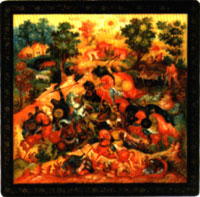
Mstyora miniature
Encyclopedia

Russia
Russia or , officially known as both Russia and the Russian Federation , is a country in northern Eurasia. It is a federal semi-presidential republic, comprising 83 federal subjects...
n folk
Folk art
Folk art encompasses art produced from an indigenous culture or by peasants or other laboring tradespeople. In contrast to fine art, folk art is primarily utilitarian and decorative rather than purely aesthetic....
handicraft
Handicraft
Handicraft, more precisely expressed as artisanic handicraft, sometimes also called artisanry, is a type of work where useful and decorative devices are made completely by hand or by using only simple tools. It is a traditional main sector of craft. Usually the term is applied to traditional means...
of miniature painting, which is done with tempera
Tempera
Tempera, also known as egg tempera, is a permanent fast-drying painting medium consisting of colored pigment mixed with a water-soluble binder medium . Tempera also refers to the paintings done in this medium. Tempera paintings are very long lasting, and examples from the 1st centuries AD still exist...
paints on varnish
Varnish
Varnish is a transparent, hard, protective finish or film primarily used in wood finishing but also for other materials. Varnish is traditionally a combination of a drying oil, a resin, and a thinner or solvent. Varnish finishes are usually glossy but may be designed to produce satin or semi-gloss...
ed articles mostly made of papier-mâché
Papier-mâché
Papier-mâché , alternatively, paper-mache, is a composite material consisting of paper pieces or pulp, sometimes reinforced with textiles, bound with an adhesive, such as glue, starch, or wallpaper paste....
.
Mstyora miniatures appeared in the settlement of Mstyora (in modern Vladimir Oblast
Vladimir Oblast
Vladimir Oblast is a federal subject of Russia . Its administrative center is the city of Vladimir, which is located east of Moscow...
) in the early 20th century on the basis of a local tradition of icon-painting. In 1923, Mstyora painters formed an artel
Artel
Artel is a general term for various cooperative associations in Russia and Ukraine, historical and modern.Historically, artels were semi-formal associations for various enterprises: fishing, mining, commerce, of loaders, loggers, thieves, beggars, etc. Often artels worked far from home and lived...
called Ancient Russian Folk Painting (Древнерусская народная живопись), renamed Proletarian Art (Пролетарское искусство) in 1931. This artel was turned into a factory in 1960. The Mstyora painting technology was borrowed from the Palekh
Palekh miniature
Palekh miniature is a Russian folk handicraft of miniature painting, which is done with tempera paints on varnished articles made of papier-mâché ....
artists.
Mstyora miniatures usually represent characters from real life, folklore
Folklore
Folklore consists of legends, music, oral history, proverbs, jokes, popular beliefs, fairy tales and customs that are the traditions of a culture, subculture, or group. It is also the set of practices through which those expressive genres are shared. The study of folklore is sometimes called...
, and literary and historical works. Warmth and gentleness of colors, depth of landscape backgrounds (often with blue dales in the back), small size and squatness of human figurines, and subtlety of framing pattern done in gold
Gold
Gold is a chemical element with the symbol Au and an atomic number of 79. Gold is a dense, soft, shiny, malleable and ductile metal. Pure gold has a bright yellow color and luster traditionally considered attractive, which it maintains without oxidizing in air or water. Chemically, gold is a...
are typical.

